The influence of American missionaries in the Philippines has left a lasting impact on the nation’s history and culture. Originating from the Latin word “missio,” meaning “to send,” the term “missionary” reflects the dedication of individuals who traveled far to share their faith and values. Their work extended beyond religion, shaping education, healthcare, and community development.
These missionaries played a pivotal role in establishing schools, hospitals, and community centers. The church became a cornerstone of social services, fostering unity and progress. Their efforts not only transformed local communities but also bridged cultural gaps between the Philippines and the United States.
This article delves into the multifaceted contributions of these individuals, exploring their impact on education, healthcare, cultural transformation, and social justice initiatives. Their legacy continues to resonate in the Philippines today.
Key Takeaways
- American missionaries significantly influenced education, healthcare, and community development in the Philippines.
- The term “missionary” stems from the Latin word “missio,” meaning “to send.”
- They established schools, hospitals, and community centers, integrating the church into social services.
- Their work bridged cultural gaps between the Philippines and the United States.
- Their legacy remains evident in the Philippines’ social and cultural landscape.
Historical Background of American Missionaries in the Philippines
During the early 20th century, American missionaries began their journey to the Philippines, driven by faith and purpose. Their arrival marked a pivotal moment in the nation’s history, as they sought to share their beliefs and values with the local persons. This movement was part of a broader global effort to spread the Christian faith, reflecting the interconnectedness of the world during that era.
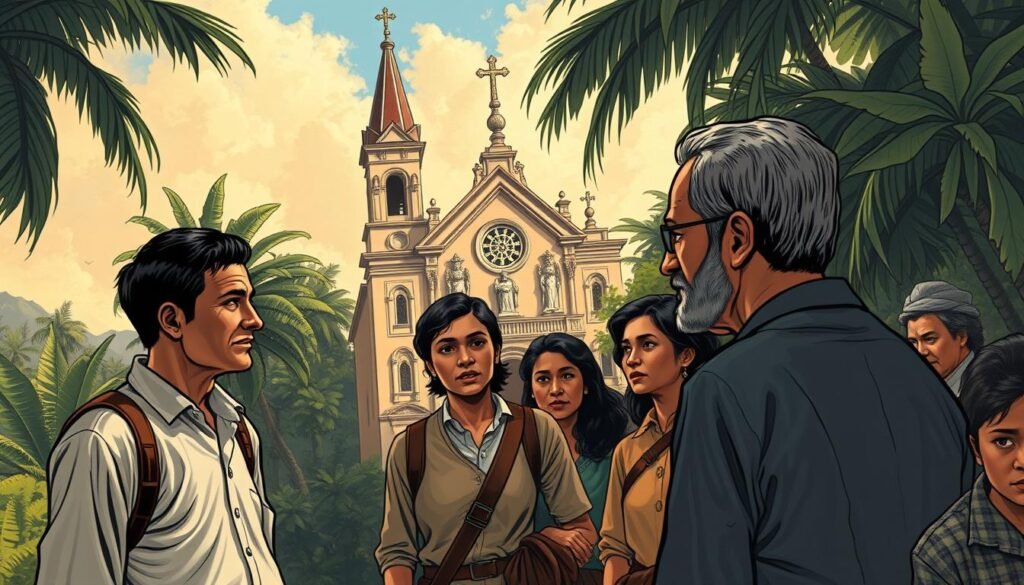
Origins and Early Arrival
The first wave of American missionaries arrived in the Philippines shortly after the U.S. took control of the islands in 1898. Many of these individuals were inspired by a sense of duty and the desire to bring about positive change. Their work was not just about religion; it also aimed to introduce American ideas and practices to the local population.
One notable group was the Thomasites, volunteer teachers who arrived in 1901. They played a crucial role in establishing the American public school system, which became a cornerstone of education in the Philippines. Their efforts laid the foundation for future generations, blending cultural exchange with academic progress.
Colonial Influence and Legacy
The arrival of American missionaries coincided with the expansion of U.S. colonial power in the region. This period saw the establishment of institutions like the Bureau of Non-Christian Tribes, which aimed to understand and integrate diverse ethnic groups. The missionaries’ work often aligned with colonial goals, creating a complex dynamic between faith and governance.
Their legacy is still evident today, particularly in the fields of education and healthcare. Schools and hospitals founded by these early missionaries continue to serve communities across the Philippines. Their contributions not only shaped the nation’s development but also fostered a unique cultural exchange that bridged two distinct worlds.
Impact on Education and Literacy
The Philippines saw a transformation in its educational landscape during the early 20th century. Dedicated individuals played a key role in establishing schools and literacy programs. Their efforts not only improved literacy rates but also introduced Western learning methods adapted to local needs.
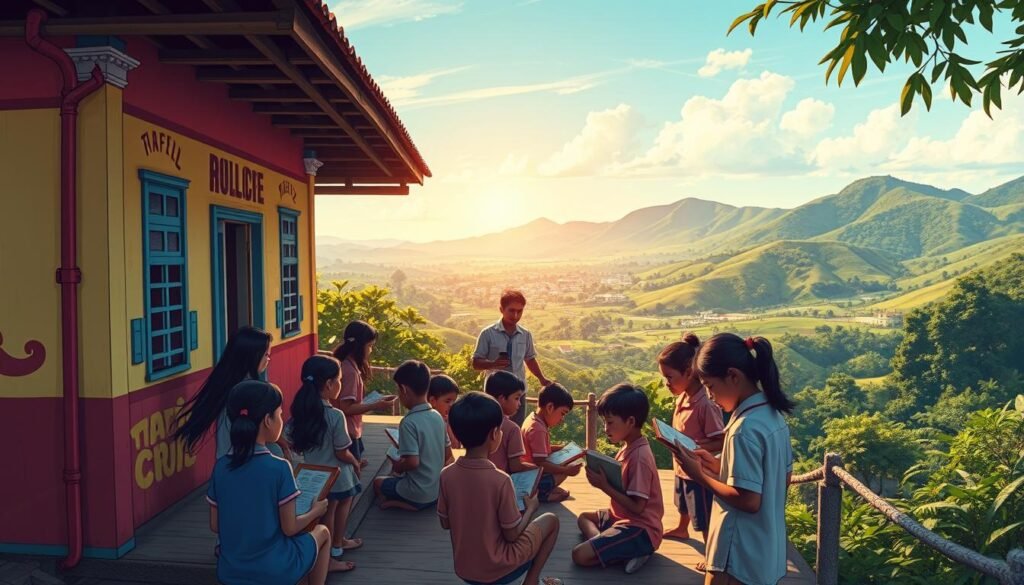
Establishment of Educational Institutions
Schools and libraries were built across the country, bringing education to underserved areas. By 1909, over 3,000 schools were operational, ranging from primary to college levels. These institutions became hubs for learning and community development.
One notable example is the work of the Thomasites, who arrived in 1901. They laid the foundation for the public school system, blending American and Filipino educational practices. This integration created a unique cultural exchange that benefited both sides.
Cultural Exchange Through Literacy
Literacy programs introduced new ideas and perspectives to local communities. Students learned not only academic subjects but also values that shaped their worldview. This exchange fostered mutual understanding and respect between cultures.
Long-term benefits included improved social mobility and economic opportunities. Education became a tool for empowerment, enabling individuals to contribute to their communities. Programs like these continue to influence the Philippines today.
For more on how education shaped the nation, explore the story of shaping education in the Philippines.
Advancements in Healthcare Through Missionary Initiatives
Healthcare in the Philippines saw significant progress through the efforts of dedicated individuals in the early 20th century. These pioneers established hospitals and clinics, bringing modern medicine to remote and underserved areas. Their work not only saved lives but also laid the foundation for the country’s public health system.
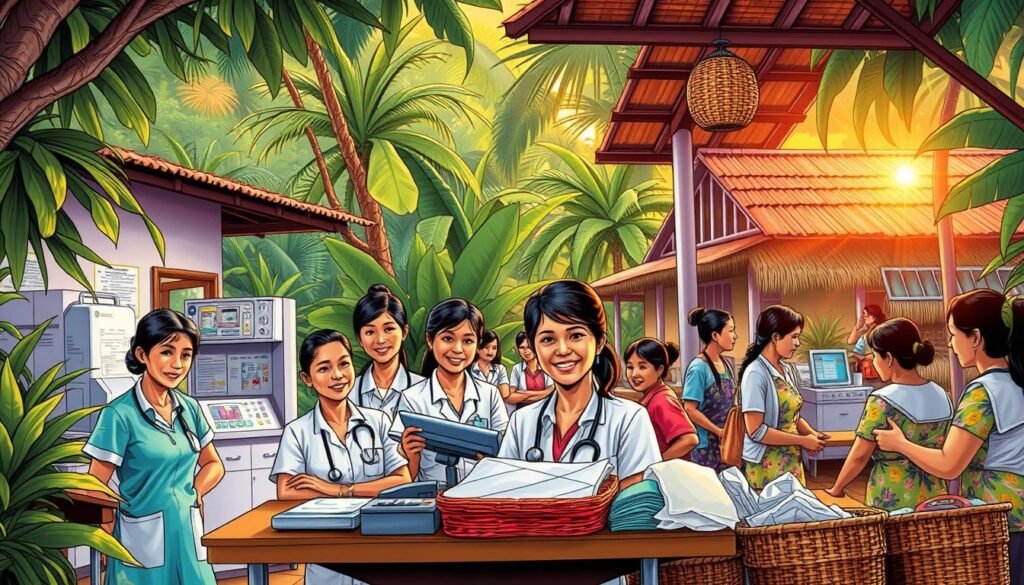
Founding of Medical Facilities
One of the most notable contributions was the establishment of medical facilities. Hospitals like Saint Luke’s Medical Center became symbols of hope and healing. These institutions provided essential services, from surgeries to maternal care, addressing critical health needs.
Collaboration with local communities was key. Missionaries worked alongside Filipino healthcare workers to promote preventative care and hygiene practices. This partnership ensured that modern medicine was accessible and culturally relevant.
“The establishment of these hospitals was a turning point in public health, bridging gaps in care and fostering trust.”
Historical examples include medical missions during epidemics, which saved countless lives. These efforts improved health outcomes and set a precedent for future initiatives. Today, the legacy of these advancements continues to shape the country’s healthcare landscape.
Spiritual and Religious Transformation in the Philippines
The spiritual landscape of the Philippines underwent profound changes during the early 20th century. The arrival of faith-driven individuals brought new religious practices and beliefs, reshaping the way communities understood spirituality. This transformation was not just about introducing Christianity but also fostering a deeper connection between faith and daily life.

Spreading the Gospel
The gospel found its way into the hearts of many Filipinos during a pivotal time in history. Early efforts focused on adapting evangelization strategies to local cultures. This included translating religious texts into native languages and incorporating indigenous traditions into worship practices.
One notable example is the Doctrina Christiana, a catechism book printed in 1593. It played a crucial role in teaching Christian principles in a way that resonated with the local population. Over time, these efforts led to widespread acceptance of the gospel, transforming religious practices across the archipelago.
Interfaith Engagement
Interfaith dialogue became an essential part of the spiritual transformation. Missionaries engaged with indigenous belief systems, fostering mutual respect and understanding. These interactions often led to peaceful coexistence and the blending of traditions.
For instance, in Mindanao, where Islam had been practiced for centuries, missionaries worked to build bridges between Christian and Muslim communities. This approach not only promoted harmony but also enriched the spiritual fabric of the region.
| Key Aspect | Impact |
|---|---|
| Spread of the Gospel | Redefined local religious practices and beliefs. |
| Interfaith Engagement | Fostered mutual respect and cultural blending. |
| Adaptation Strategies | Ensured the gospel resonated with diverse populations. |
The spiritual influence of this time continues to shape religious thought in the Philippines today. The peaceful spread of the gospel and interfaith engagement remain a testament to the transformative power of faith.
Community Building and Social Service Contributions
Community centers became vital hubs for social and spiritual growth in the Philippines, thanks to the efforts of faith-driven individuals. These centers were more than just places of worship; they served as foundations for education, healthcare, and social welfare. By addressing critical needs, they brought hope and transformation to countless lives.
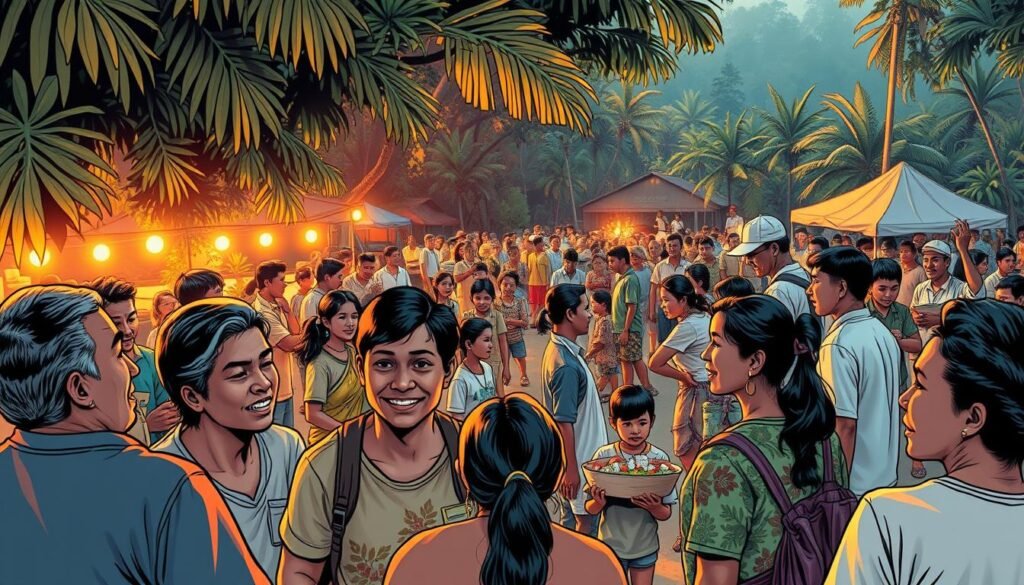
Building Community Centers
Community centers were established as safe spaces where people could gather, learn, and grow. They hosted religious activities, literacy programs, and vocational training. These initiatives empowered individuals to improve their lives and contribute to their communities.
One notable example is the establishment of centers in remote areas, where access to education and healthcare was limited. These centers became lifelines, offering resources and support to those in need. The focus on christ-centered values ensured that every effort was rooted in compassion and service.
Social Welfare Initiatives
Social programs addressed pressing issues like poverty, health, and literacy. Initiatives included food distribution, medical missions, and disaster relief efforts. These programs were designed to uplift the most vulnerable and create lasting change.
For instance, during natural disasters, community centers provided immediate aid and long-term recovery support. The emphasis on life-saving measures and sustainable solutions demonstrated a commitment to holistic care. “We saw communities come together, united by a shared vision of hope and resilience,” shared one volunteer.
Today, the legacy of these initiatives continues to shape modern social services in the Philippines. The principles of faith, service, and community remain at the heart of these efforts, ensuring that the work of the past inspires the future.
Cultural Integration and Transformation
The fusion of Filipino and Western traditions created a unique cultural identity in the Philippines. This blending of practices was not just about adopting new ideas but also preserving local heritage. Leaders played a crucial role in facilitating this exchange, ensuring that both cultures enriched each other.
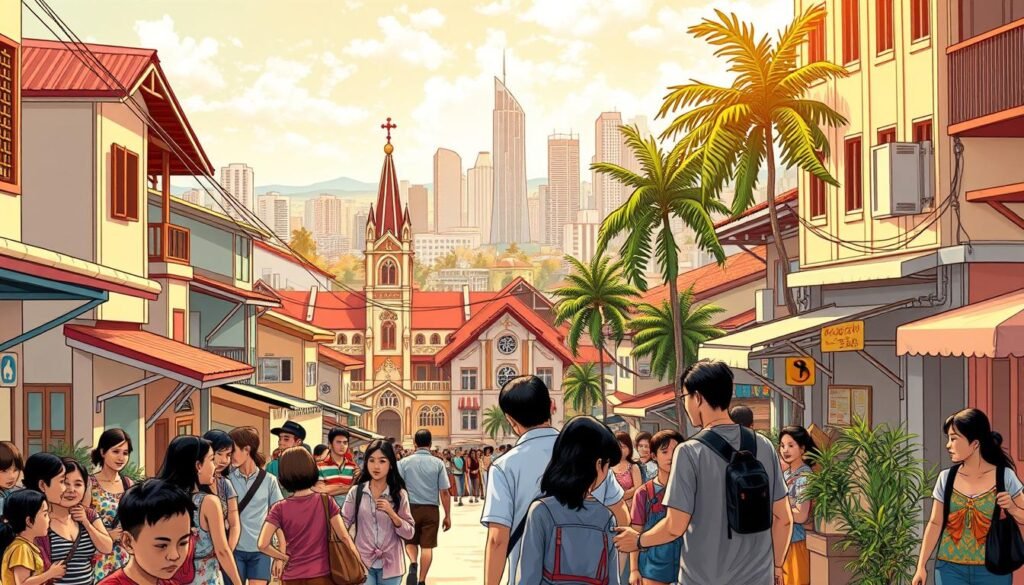
Fusion of Filipino and Western Traditions
The integration of Western practices with Filipino traditions was a gradual process. Leaders acted as bridges, introducing new customs while respecting local values. For example, Western-style education was adapted to include Filipino history and culture, creating a balanced curriculum.
Mutual cultural exchanges also flourished. Festivals like Pahiyas incorporated Western elements, such as parades and pageants, while retaining their traditional roots. This blend of traditions became a symbol of unity and shared progress.
Challenges and Solutions
Cultural integration was not without challenges. Differences in beliefs and practices sometimes led to misunderstandings. However, dialogue and collaboration helped overcome these obstacles. Leaders emphasized common values, fostering mutual respect and cooperation.
For instance, the apostle Paul’s approach to intercultural engagement inspired many. By identifying with diverse groups, he demonstrated how cultural sensitivity could bridge divides. This principle guided efforts to harmonize Filipino and Western traditions.
Examples of Cultural Fusion
Educational reforms were a significant outcome of this cultural exchange. Schools introduced bilingual programs, teaching both English and Filipino languages. This approach not only improved literacy but also promoted cultural pride.
Festivals also reflected this fusion. The Sinulog festival, for example, combines Catholic traditions with indigenous dances, celebrating both faith and heritage. Such events highlight the enduring impact of cultural integration.
| Key Aspect | Impact |
|---|---|
| Educational Reforms | Blended Western and Filipino curricula, enhancing learning. |
| Festivals | Integrated traditions, fostering unity and cultural pride. |
| Leadership | Facilitated dialogue and mutual understanding. |
Today, the legacy of this cultural integration continues to shape the Philippines. The harmonious blending of traditions serves as a testament to the power of collaboration and respect. Leaders and communities alike remain committed to preserving this unique cultural identity.
Analysis of Missionary Strategies Over Time
The strategies of spreading faith have evolved significantly over the centuries, adapting to cultural and technological changes. Early efforts focused on personal evangelization, often through direct engagement with communities. Today, these methods have expanded to include digital outreach, reflecting the changing ways people connect.
In the past, the mission of sharing the gospel relied heavily on face-to-face interactions. Leaders like Paul traveled extensively, establishing churches and nurturing new believers. Their work was rooted in the teachings of Jesus Christ, emphasizing personal transformation and community building.

Modern strategies have embraced technology, using social media, podcasts, and online platforms to reach wider audiences. This shift allows for greater accessibility, especially in regions where traditional methods face challenges. The holy message remains unchanged, but the delivery has adapted to contemporary needs.
“The digital age has opened new doors for spreading the gospel, making it possible to connect with people across the globe.”
Comparing past and present, one notable difference is the emphasis on cultural sensitivity. Early evangelization often imposed foreign practices, while modern approaches prioritize understanding and integrating local traditions. This evolution has fostered deeper connections and mutual respect.
Examples of adaptation include the use of media to share stories of faith. Documentaries, films, and music have become powerful tools for communicating the teachings of Jesus Christ. These methods resonate with diverse audiences, bridging gaps between cultures and generations.
Despite these advancements, the core principles of the mission remain the same: evangelism, discipleship, and church planting. The strategies may change, but the goal of sharing the holy message continues to inspire and transform lives.
Missionaries – A Catalyst for Educational Reform
The educational landscape of the Philippines was reshaped by the introduction of modern teaching methods and curricula during the early 20th century. Faith-driven individuals played a pivotal role in this transformation, bringing innovative approaches that diverged from traditional instruction. Their efforts not only improved literacy rates but also laid the foundation for a more inclusive and progressive educational system.

Innovative Learning Methods
One of the most significant contributions was the introduction of modern subjects and pedagogical techniques. Faith-driven educators emphasized critical thinking and practical skills, moving away from rote memorization. For example, subjects like science, mathematics, and English were integrated into the curriculum, preparing students for a rapidly changing world.
Historical records show that by the mid-20th century, over 1,500 primary schools had been established across the country. These institutions adopted bilingual education, teaching both English and Filipino languages. This approach not only enhanced literacy but also fostered cultural pride and global connectivity.
“The introduction of modern education was a turning point, empowering communities and opening doors to new opportunities.”
Long-Term Community Benefits
The impact of these educational reforms extended far beyond the classroom. Regions with a higher concentration of faith-driven schools saw a 25% increase in educational attainment. Graduates of these institutions often became teachers, healthcare workers, and community leaders, driving further progress.
By the 1960s, vocational training programs had produced a 40% increase in skilled labor. These programs equipped individuals with practical skills, improving economic stability and social mobility. The legacy of these initiatives continues to shape the Philippines today, with many schools and colleges founded during that era still operational.
| Key Aspect | Impact |
|---|---|
| Modern Subjects | Enhanced critical thinking and practical skills. |
| Bilingual Education | Improved literacy and cultural pride. |
| Vocational Training | Increased skilled labor and economic stability. |
The enduring benefits of these educational reforms highlight the transformative power of faith-driven initiatives. By prioritizing education, these individuals not only improved individual lives but also strengthened entire communities.
Lessons Learned from Colonial Missionary Efforts
Colonial missionary efforts in the Philippines offer valuable insights into the complexities of cultural exchange. These initiatives brought both transformative successes and unintended consequences, shaping the nation’s social and cultural fabric. By examining their work, we can better understand the delicate balance between cultural preservation and transformation.

Successes and Shortcomings
Colonial missionaries achieved significant milestones, particularly in education and healthcare. They established schools and hospitals, improving literacy rates and public health. However, their approach often clashed with indigenous traditions, leading to cultural tensions. For example, the introduction of Western practices sometimes overshadowed local customs, creating a sense of cultural imperialism.
One notable success was the integration of modern education, which empowered communities and fostered social mobility. Yet, the imposition of foreign values often alienated indigenous groups, highlighting the need for cultural sensitivity in humanitarian efforts.
Impact on Indigenous Cultures
The arrival of missionaries profoundly affected indigenous cultures. While some communities embraced new religious practices, others resisted, striving to preserve their heritage. In regions with a strong muslim presence, missionary efforts faced significant challenges, as local traditions were deeply rooted in Islamic teachings.
Historical records show that the teachings of Jesus Christ were often adapted to resonate with local beliefs. This approach fostered mutual understanding but also led to the blending of traditions, altering the cultural landscape in lasting ways.
“The impact of missionary work on indigenous cultures reveals both the potential for unity and the risks of cultural erasure.”
Long-term consequences included the emergence of hybrid cultural practices, which continue to shape the Philippines today. While some communities thrived under missionary influence, others struggled to reconcile their heritage with external pressures.
- Missionary efforts improved education and healthcare but often conflicted with indigenous traditions.
- The teachings of Jesus Christ were adapted to local contexts, fostering both acceptance and resistance.
- Cultural imperialism sometimes overshadowed the intended humanitarian goals.
For modern society, these lessons emphasize the importance of cultural sensitivity and collaboration. By learning from the past, we can ensure that future efforts respect and empower local communities. For further reflection on decolonizing missionary work, explore this personal reflection.
Evolution of Missionary Communication and Outreach
Modern technology has revolutionized how faith-based messages are shared globally. From traditional face-to-face interactions to digital platforms, the methods of outreach have evolved to meet the needs of a connected world. This transformation has allowed faith-driven individuals to reach broader audiences and foster deeper connections.
Transition from Traditional to Digital Outreach
In the past, outreach relied heavily on personal interactions and handwritten letters. Faith-driven individuals traveled extensively to share their message, often facing challenges like language barriers and geographical limitations. Today, digital tools like social media, podcasts, and video conferencing have made it easier to connect with people across the globe.
One notable example is the use of social media campaigns to engage with younger audiences. Platforms like Facebook and Instagram allow faith-based groups to share inspirational content, host live events, and build online communities. This shift has not only expanded reach but also created opportunities for real-time engagement.
Benefits of Modern Communication Methods
Digital outreach offers several advantages. It allows for instant communication, making it easier to share updates and respond to inquiries. Online platforms also provide a space for global collaboration, enabling faith-driven individuals to work together on shared goals.
For instance, america-based organizations have used digital tools to support local members in the Philippines. Online training programs and virtual meetings have empowered communities to take charge of their own development. This approach fosters self-sustainability and long-term growth.
“The digital age has opened new doors for spreading faith, making it possible to connect with people across the globe.”
Examples of Successful Digital Campaigns
Several faith-based groups have launched successful digital evangelization campaigns. For example, online Bible study programs have attracted participants from diverse backgrounds. These programs use interactive tools like quizzes and discussion forums to enhance learning and engagement.
Another example is the use of mobile apps to share daily devotionals and prayer requests. These apps provide a convenient way for individuals to stay connected with their faith community, even on the go. Such initiatives highlight the potential of technology to transform outreach efforts.
For more insights on how technology is revolutionizing mission work, explore this detailed analysis.
Impact of Technological Advancements
Technology has not only expanded reach but also deepened connections. Virtual events like webinars and online conferences allow faith-driven individuals to share their message with a global audience. These events often feature guest speakers from different parts of the world, fostering cross-cultural understanding.
In the Philippines, digital tools have enabled local groups to collaborate with international partners. This partnership has led to the development of innovative programs addressing social issues like poverty and education. The integration of technology into outreach efforts continues to shape the future of faith-based communication.
Promoting Social Justice Through Faith and Service
Faith-based initiatives have long been a driving force for social justice in the Philippines, blending spiritual guidance with tangible community action. These efforts have not only addressed immediate needs but also laid the groundwork for systemic change. By integrating faith with service, these initiatives have empowered communities and advocated for lasting reforms.
Empowering Underrepresented Communities
Programs aimed at uplifting marginalized groups have been a cornerstone of faith-driven social justice. From providing education to offering healthcare, these initiatives have focused on creating opportunities for those often left behind. For example, Catholic missionaries established over 1,000 schools worldwide, significantly improving literacy rates in underserved areas.
In the Philippines, these efforts have led to a 20% increase in literacy rates in regions with active missionary work. By addressing both spiritual and material needs, these programs have fostered a sense of dignity and self-worth among participants.
Advocating for Social Reforms
Faith-based organizations have also been at the forefront of advocating for social reforms. From fighting poverty to promoting human rights, these groups have used their platforms to drive change. For instance, Catholic healthcare initiatives have resulted in the establishment of over 300 clinics in remote areas, providing essential medical services to millions.
These efforts are rooted in the teachings of Jesus Christ, emphasizing compassion and justice. By aligning their work with these principles, faith-driven individuals have inspired communities to take collective action.
“The integration of faith and works is essential, as believers are encouraged to embody their faith through tangible actions that reflect Christ’s love and commitment to justice.”
For more on how faith and social justice intersect, explore the New Evangelization and Social Justice.
| Key Aspect | Impact |
|---|---|
| Education | Improved literacy rates and access to schooling. |
| Healthcare | Established clinics, providing essential medical services. |
| Social Reforms | Advocated for human rights and poverty alleviation. |
| Community Empowerment | Fostered dignity and self-worth among participants. |
Economic and Social Contributions of Missionary Initiatives
Faith-based efforts played a pivotal role in fostering economic growth and community development in the Philippines. These initiatives went beyond spiritual guidance, addressing critical needs and creating lasting change. By integrating faith with service, they empowered local communities and laid the foundation for sustainable progress.
Mission-Driven Economic Development
Faith-driven groups established networks that supported local businesses and industries. For example, protestant initiatives introduced modern agricultural techniques, improving crop yields and livelihoods. These efforts not only boosted economic activity but also encouraged self-sufficiency.
In urban areas, church-related projects created jobs and stimulated growth. Rural regions benefited from infrastructure improvements like roads and water systems. These developments enhanced access to markets and resources, fostering economic stability.
Community Projects and Infrastructure
Faith-based organizations initiated numerous community projects. Schools, hospitals, and vocational training centers were built to address local needs. These facilities became hubs for education, healthcare, and skill development, empowering individuals to contribute to their communities.
One notable example is the construction of community centers that hosted workshops and training programs. These spaces encouraged collaboration and innovation, driving further progress. The long-term benefits of these projects continue to shape the Philippines today.
| Key Aspect | Impact |
|---|---|
| Agricultural Development | Improved crop yields and livelihoods. |
| Infrastructure Projects | Enhanced access to markets and resources. |
| Community Centers | Fostered collaboration and skill development. |
| Healthcare Facilities | Provided essential medical services. |
The economic and social contributions of these initiatives highlight the transformative power of faith-driven efforts. By addressing both material and spiritual needs, they created a legacy of progress and empowerment. For more insights, explore the role of faith-based initiatives in community.
Modern Missionary Approaches in the 21st Century
In the 21st century, faith-driven initiatives have embraced technology to redefine outreach and community engagement. These modern approaches reflect a shift from traditional methods to innovative strategies that leverage digital tools. By integrating technology, these efforts have expanded their reach and deepened their impact.
Adapting to Technological Advances
Technology has become a cornerstone of modern outreach. Social media platforms, podcasts, and online forums are now essential tools for sharing faith-based messages. For example, digital campaigns have enabled faith-driven groups to connect with younger audiences, fostering engagement through interactive content.
Online platforms also facilitate global collaboration. Faith-based organizations can now partner with local communities worldwide, supporting initiatives like school construction and healthcare programs. This approach ensures that resources are effectively utilized to address pressing needs.
Contemporary Evangelical Practices
Contemporary practices differ significantly from traditional methods. Modern evangelism emphasizes cultural sensitivity and inclusivity. For instance, the bible is often translated into local languages, making it accessible to diverse populations. This approach fosters deeper connections and mutual respect.
Another innovative practice is the use of mobile apps for daily devotionals and prayer requests. These apps provide a convenient way for individuals to stay connected with their faith community, even on the go. Such initiatives highlight the potential of technology to transform outreach efforts.
- Digital tools like social media and podcasts have expanded the reach of faith-based messages.
- Online platforms enable global collaboration, supporting education and healthcare initiatives.
- Contemporary practices focus on cultural sensitivity and inclusivity, making the bible accessible to diverse populations.
- Mobile apps provide a convenient way for individuals to stay connected with their faith community.
“The integration of technology into outreach efforts has opened new doors for spreading faith, making it possible to connect with people across the globe.”
These modern approaches are making a tangible difference in society today. By embracing technology and innovative practices, faith-driven initiatives continue to inspire and transform lives. Their work serves as a testament to the enduring power of faith in the digital age.
Global and Local Perspectives on Missionary Impact
The global and local impact of faith-driven efforts in the Philippines reflects a unique blend of cultural exchange and shared values. These initiatives have not only transformed local communities but also drawn inspiration from global movements, creating a dynamic interplay of traditions. By examining these efforts, we can better understand how partnerships and adaptations have shaped the nation’s social and spiritual landscape.
Cross-Cultural Exchanges
Cross-cultural exchanges have been a cornerstone of faith-driven efforts in the Philippines. These interactions have fostered mutual understanding and respect, blending local traditions with global practices. For example, the integration of Western education methods with Filipino cultural values has created a unique educational system that benefits both parties.
In other asian countries, similar efforts have led to the establishment of schools and healthcare facilities. These initiatives often involve international partnerships, where resources and expertise are shared to address local needs. Such collaborations highlight the importance of cultural sensitivity and adaptability in achieving long-term success.
Comparative Global Inspirations
The Philippines’ experience with faith-driven efforts can be compared to other asian nations like India and Thailand. In these countries, global inspirations have shaped local mission strategies, leading to innovative approaches in education, healthcare, and community development. For instance, the use of mobile clinics in rural areas has been a successful model in both the Philippines and India.
Global missions have also inspired local adaptations, such as the incorporation of indigenous practices into worship. This approach ensures that faith-driven efforts resonate with local communities while maintaining their global roots. As one effort leader noted, “The key to success lies in understanding and respecting the cultural context.”
“The integration of global and local perspectives has created a powerful synergy, driving meaningful change in communities worldwide.”
Successful international partnerships, like those supported by the Alliance World Fellowship, demonstrate the benefits of collaborative efforts. These initiatives not only address immediate needs but also build capacity for sustainable development. By learning from global experiences, local communities can implement best practices that enhance their own efforts.
In conclusion, the interplay between global and local perspectives has redefined faith-driven efforts in the Philippines. By fostering cross-cultural exchanges and drawing inspiration from global movements, these initiatives continue to create lasting impact. Their legacy serves as a testament to the power of collaboration and cultural sensitivity in achieving meaningful change.
Reflecting on the Legacy in Today’s Philippines
Personal stories from communities across the Philippines reveal the lasting impact of historical initiatives. From bustling cities to remote villages, the echoes of faith-driven efforts continue to shape lives. These narratives offer a glimpse into how colonial influences have intertwined with local traditions, creating a unique cultural tapestry.
Voices from the Community
Local leaders and everyday individuals share their reflections on the long-term effects of these initiatives. For many, the establishment of schools and hospitals remains a cornerstone of progress. “The education I received opened doors I never thought possible,” shared Maria, a teacher from Cebu. Her story highlights the transformative power of faith-based efforts in empowering communities.
In rural areas, the legacy of these initiatives is equally profound. Farmers in the place of Negros Oriental credit agricultural programs introduced decades ago for their current livelihoods. These programs, rooted in compassion and service, continue to foster self-sufficiency and economic stability.
Colonial Influences and Modern Perceptions
The colonial era left an indelible mark on Filipino society, shaping perceptions of religion and community. While some view these influences as a foundation for unity, others grapple with the complexities of cultural integration. Local historian Dr. Santos notes, “The blending of traditions has created a unique identity, but it also challenges us to reconcile our past with our present.”
This duality is evident in the Philippines’ vibrant festivals, where Catholic traditions merge with indigenous practices. Events like the Sinulog Festival in Cebu celebrate this fusion, showcasing the enduring connection between faith and culture.
Enduring Human Connections
Testimonials from across the country highlight the enduring human connections forged by these initiatives. In Mindanao, interfaith dialogues have fostered peace between Christian and Muslim communities. “We’ve learned to respect each other’s beliefs while working together for our shared future,” shared Imam Ali, a community leader.
These stories underscore the importance of empathy and collaboration in building a harmonious society. They also reflect the ongoing influence of historical legacies in shaping modern progress.
| Key Aspect | Impact |
|---|---|
| Education | Empowered individuals and improved literacy rates. |
| Healthcare | Provided essential services to underserved areas. |
| Cultural Integration | Fostered unity through blended traditions. |
| Community Development | Built infrastructure and supported local economies. |
As the Philippines continues to evolve, the legacy of these initiatives serves as a reminder of the power of faith and service. For more on how this legacy inspires modern efforts, explore the 150th anniversary of Adventist missionary work.
Conclusion
The legacy of American efforts in the Philippines remains deeply rooted in the nation’s history. From education to healthcare, their contributions have shaped the colony into a thriving society. Schools and hospitals built during this era continue to serve as pillars of progress, reflecting their enduring impact.
Community development was another cornerstone of their work. By fostering unity and economic growth, they laid the foundation for a brighter future. Their innovative practices bridged cultural gaps, blending traditions to create a unique home for Filipinos.
Lessons from these efforts highlight the importance of cultural sensitivity and collaboration. Modern initiatives draw inspiration from this legacy, ensuring that progress continues. For insights on integrating faith with local communities, explore this resource.
Today, the Philippines stands as a testament to the transformative power of faith-driven service. Their work not only shaped the past but continues to inspire a better tomorrow.
FAQ
When did American missionaries first arrive in the Philippines?
American missionaries began arriving in the Philippines in the late 19th century, particularly after the Spanish-American War in 1898.
What role did missionaries play in education in the Philippines?
They established schools and universities, promoting literacy and introducing Western educational methods that shaped the country’s academic system.
How did missionary efforts impact healthcare in the Philippines?
Missionaries founded hospitals and clinics, providing medical care and training local healthcare workers, which improved public health standards.
What was the spiritual impact of missionaries in the Philippines?
They spread Christian teachings, leading to the growth of Protestantism and fostering interfaith dialogue in a predominantly Catholic country.
Did missionaries contribute to community development in the Philippines?
Yes, they built community centers and initiated social welfare programs, addressing needs like poverty and education in local areas.
How did missionaries influence Filipino culture?
They introduced Western traditions, which blended with local customs, creating a unique cultural fusion still evident today.
What were some challenges faced by missionaries in the Philippines?
They encountered resistance from indigenous cultures, language barriers, and the complexities of colonial politics.
How have missionary strategies evolved over time?
From traditional methods like preaching and teaching, they now use digital tools and modern outreach strategies to connect with communities.
What is the legacy of American missionaries in the Philippines today?
Their contributions to education, healthcare, and social services continue to shape Filipino society, leaving a lasting positive impact.
How do modern missionaries adapt to 21st-century challenges?
They leverage technology, focus on social justice, and engage in sustainable community development to address contemporary issues.
Source Links
- American Women in the Philippines · The Philippines and the University of Michigan, 1870-1935 · Philippines
- Canadian Review of American Studies
- Presbyterian Missionaries in the Philippines: Conduits of Social Change, 1899–1910. By Anne C. Kwantes. Quezon City, Philippines: New Day Publishers, 1989. xiv + 238 pp. $12.75 paper
- 500TH ANNIVERSARY OF THE FAITH IN THE PHILIPPINES (6) – The Philippine Church during the American Colonial Period
- Protestant Missionaries in the Philippines, 1898–1916: An Inquiry into the American Colonial Mentality. By Kenton J. Clymer. Urbana, Illinois: University of Illinois Press. xi + 267 pp. $28.95
- Literacy, Education, and the Spread of the Gospel
- Empowering the Unreached: Education, Literacy, and Access to the Gospel
- On missional medicine: institution building, fragile places, and sheep among wolves | Christian Journal for Global Health
- Research as mission: Experiences and expectations of mission agency leadership regarding the ministry role of clinical and public health research | Christian Journal for Global Health
- Catholicism in the Philippines during the Spanish Colonial Period 1521-1898 | 4 Corners of the World
- Five Hundred Years of Christianity in the Philippines: Some Critical Issues and Challenges for Today’s Missionaries
- Colonialism Brought Evangelicalism to the Philippines. Churches Are Now Untangling the Two. – Christianity Today
- 5 Important Reasons How A Missionary Can Transform A Local Community
- Evaluating an Integrated Psychosocial Approach to Ebola Virus Disease Prevention and Containment in Lofa County, Liberia
- Community Development
- Integrating the Gospel with Culture Responsibly
- Intercultural Mission and Ministry – “Unity in Diversity, Embracing All Cultures”
- The Goal of Missions and the Work of Missionaries
- Brief History of Methods and Trends of Missions
- Are Missionaries Good for the World? – IMB
- How Christian Missionaries Changed the World — Gateways To Better Education
- The Missionary Roots of Liberal Democracy | American Political Science Review | Cambridge Core
- Mission Principles Today: Lessons Learned From Yesterday
- The Significance of Spanish Colonial Missions in our National Story and our Common Heritage with Spain, Mexico and Latin America – Spanish Missions/Misiones Españolas (U.S. National Park Service)
- Role of Christian Missionaries in Colonial Africa
- Missions-Focused: From a Rich History to an Ongoing Practice
- Understanding Christian Mission Work: The Role and Responsibilities of Missionaries – Jesus Film Project
- Christian mission
- The Service of Faith and the Promotion of Justice,” General Congregation 32 (1975) – Portal to Jesuit Studies
- The Role of Catholic Missionaries in Promoting Global Faith and Service – Catholicism
- Christian Missionaries: Meaning, History, Impact, Work
- The Missionary Approach to Development: Ensuring Inclusive and Equitable Quality Education for the Most Marginalized
- The economics of missionary expansion: evidence from Africa and implications for development – Journal of Economic Growth
- The 21st Century Missionary | For The Church
- The Modern Missionary | BU Today | Boston University
- What is global missions? And why does it matter?
- Globalization and the Christian Mission | Tabletalk
- Is Global Missions Colonization?
- Catholicism in the Philippines: A Legacy of Spanish Colonization – Pinas Culture
- What impact did Catholic missions have on Filipino nationalism? | TutorChase
- A Legacy Cast In Stone – World Mission
- The Conclusion of the First Missionary Journey (Acts 14:1-28)
- Conclusion: missionary writing, the imperial archive and postcolonial politics – Missionary Writing and Empire, 1800–1860
- Synodality: A conversion aimed at becoming more missionary – Vatican News

